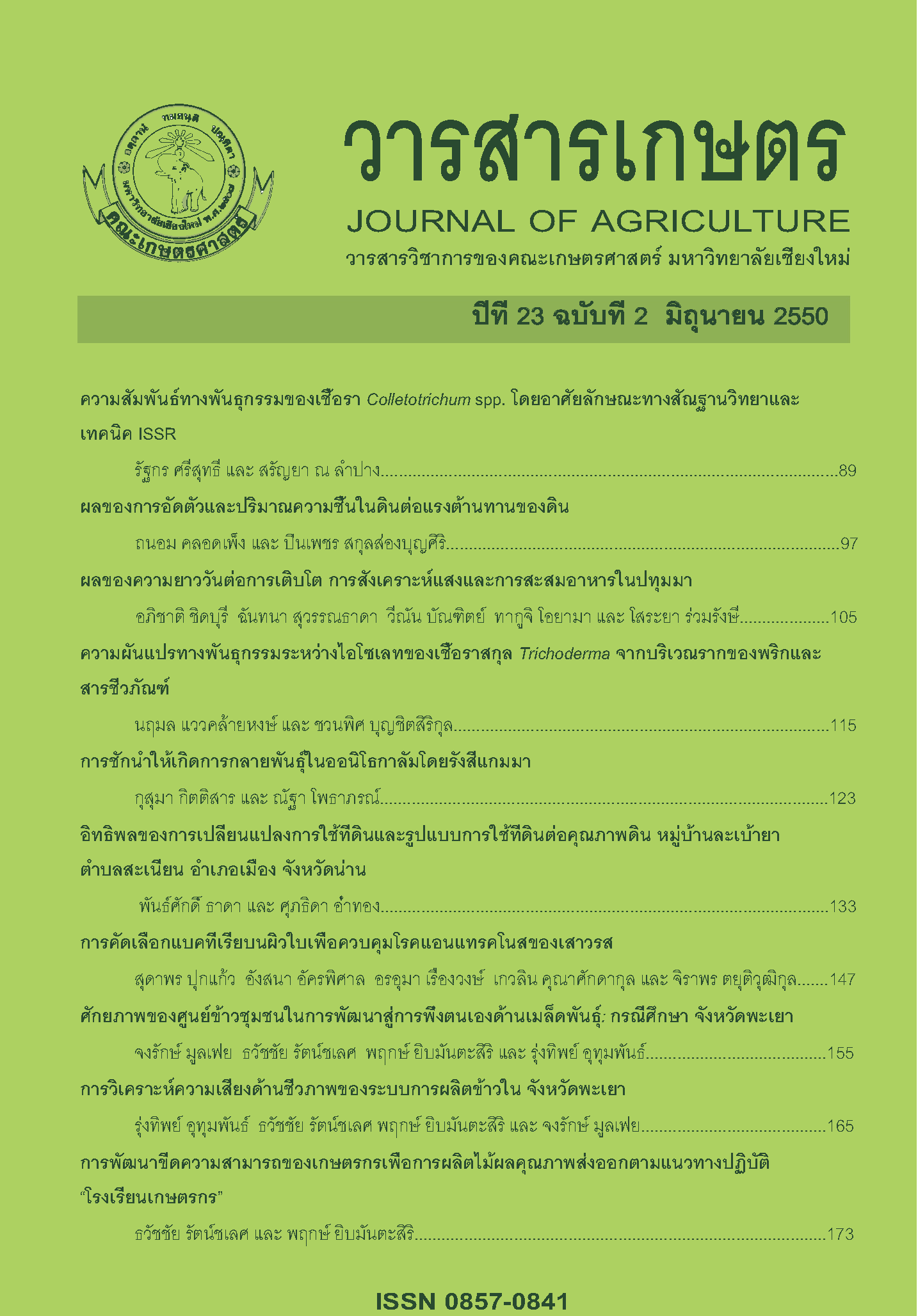อิทธิพลของการเปลี่ยนแปลงการใช้ที่ดินและรูปแบบ การใช้ที่ดินต่อคุณภาพดิน หมู่บ้านละเบ้ายา ตำบลสะเนียน อำเภอเมือง จังหวัดน่าน
Main Article Content
บทคัดย่อ
คุณภาพดินของพื้นที่แบบต่างๆ โดยมีคุณสมบัติดินที่วิเคราะห์ได้เป็นตัวชี้วัดนั้นเก็บตัวอย่างดินที่เป็นตัวแทนของรูปแบบการใช้ที่ดินแบบต่าง ๆ จำนวนทั้งสิ้น 30 แปลง เก็บตัวอย่างดินภายในแปลงย่อยจำนวน 4 ซ้ำ (pseudo replication) จากผลการศึกษาพบว่า การเปลี่ยนพื้นที่ป่าใช้สอยไปเป็นพื้นที่เพื่อการเกษตรแบบต่างๆ ของพื้นที่สูงจะมีเนื้อดินที่มีความละเอียดเพิ่มขึ้น ส่วนค่าความหนาแน่นของดิน (Bd) พบว่าในพื้นที่ทำการเกษตรมีค่า Bd สูงกว่าดินที่ไม่ได้ทำการเกษตร สำหรับค่า pH พบว่าพื้นที่ทำการเกษตรจะมีค่า pH ในพื้นที่พืชไร่ และพื้นที่ไม้ผล ต่ำกว่าพื้นที่ป่าใช้สอยและพื้นที่ไร่เหล่า ส่วนปริมาณอินทรียวัตถุ (OM) ในพื้นที่ทำการเกษตรต่ำกว่าพื้นที่ป่าใช้สอย เนื่องจากมีอัตราการสะสมของเศษซากพืชน้อยกว่าการย่อยสลาย
ค่า CEC ของดินที่ใช้ทำการเกษตรมีแนวโน้มต่ำกว่าดินที่เป็นป่าใช้สอย โดยเฉพาะดินที่ปลูกพืชไร่ติดต่อกัน เช่นเดียวกับปริมาณ total nitrogen ในพื้นที่ไม้ผลมีค่าต่ำอย่างมีนัยสำคัญทางสถิติ แต่สำหรับพื้นที่ไร่เหล่ามีปริมาณฟอสฟอรัสที่เป็นประโยชน์สูงกว่าการใช้ที่ดินรูปแบบอื่นๆ อย่างมีนัยสำคัญทางสถิติ ในขณะที่พื้นที่ไร่เหล่าจะมีค่า exchangeable K, Ca และ Mg สูงกว่ารูปแบบการใช้ที่ดินแบบอื่น ส่วนพื้นที่พืชไร่มีค่า POC สูง แต่อย่างไรก็ตามในการศึกษาครั้งนี้ POC ไม่ตอบสนองต่อการเปลี่ยนแปลงการใช้ที่ดิน สำหรับค่า EC ของดินพบว่าพื้นที่การเกษตรนั้นมีค่า EC ต่ำกว่าพื้นที่แบบอื่น
Article Details
เอกสารอ้างอิง
ปัทมา วิตยากร. 2533. ดิน: แหล่งธาตุอาหารของพืช. ภาควิชาปฐพีวิทยา คณะเกษตรศาสตร์ มหาวิทยาลัยขอนแก่น, ขอนแก่น. 211 หน้า.
พันธ์ศักดิ์ ธาดา. 2550. ผลของการเปลี่ยนแปลงการใช้ที่ดินและรูปแบบการใช้ที่ดินต่อคุณภาพดินกรณีศึกษา: หมู่บ้านละเบ้ายา ต.สะเนียน อ.เมือง จ.น่าน. วิทยานิพนธ์ปริญญาโท. มหาวิทยาลัยแม่โจ้, เชียงใหม่.105 หน้า.
ระวี รัตนาคม. 2548. ผลกระทบของไฟต่อดินในป่าเต็งรัง ณ อุทยานแห่งชาติดอยสุเทพ-ปุย. วิทยานิพนธ์ปริญญาโท. มหาวิทยาลัยแม่โจ้, เชียงใหม่.167 หน้า.
Alexander, T.G. and J. A. Robertson. 1970. Ascorbic acid as a reductant for inorganic phosphorus determination in Chang and Jackson fractionation procedure. Soil Science 110:361-362.
Anderson, J.A. and J.S.I. Ingram. 1993. Tropical soil biology and fertility: a handbook of methods 2nd edition. CAB International, Wallingford, Oxon, UK. 240 pp.
Aumtong, S. 2005. Soil carbon fractions and carbon fractions stock under agroecological land use succession in Khun Samun Watershed, Northern Thailand. The paper presented at academic seminar on “Sustainable of Land Use and Resource Management”, 16-17 December 2005, Maejo University, Thailand.13 pp.
Boonyanuphap, J. 2005. Soil nutrient status affected by burning practice and fallow period in lower Northern Thailand. Proceedings of the 31st Congress on Science and Technology of Thailand at Suranaree University of Technology, 18 – 20 October 2005, Nakhon Ratchasima, Thailand.
Borggaard, O.K. and B. Elberling. 2004a. Pedological Biogeochemistry, Part 1. Paritas Grafik A/S Brondby. 276 pp.
Borggaard, O.K. and B. Elberling. 2004b. Pedological Biogeochemistry, Part 2. Paritas Grafik A/S Brondby. 488 pp.
Bremner, J. M. and C.S. Mulvaney. 1982. Total nitrogen. pp. 595-622 In: Page A.L., R.H. Miller ,and D.R. Keeney (eds). Methods of soil analysis, Part 2. Chemical and Microbiological Properties , Second Edition. American Society of Agronomy, Medison, WI. 1159 pp.
Bruun, T.B., O. Mertz and B. Elberling. 2006. Linking yields of upland rice in shifting cultivation to fallow length and soil properties. Agriculture Ecosystems and Environment 113:139-149.
Buol, S .W., R.J. Southard, R. C. Graham and P.A. McDaniel. 2003. Soil Genesis and Classification ,5 th edition. The Iowa State Univ. Press., Ames, Iowa. 494 pp.
Chen, J.S. and C.Y. Chiu. 2000. Effect of topography on the composition of soil organic substances in a perhumid sub-tropical montane forest ecosystem in Taiwan. Geoderma 96:19-30.
Fynn, R. W.S., R. J. Haynes and T.G. O’ Connor. 2003. Burning causes long-term changes in soil organic matter content of a South African grassland. Soil Biology and Biochemistry 35: 677-687.
Gee, G.W. and J.W. Bauder. 1986. Particle-size analysis. pp. 383-411. In Klute, A. (ed.). Methods of Soil analysis, Part I. Physical and Mineralogical Methods. Agronomy Monograph 9, 2nd edition. America Society of Agronomy, Madison, WI.1188 pp.
Giardina, C.P., R.L. Sanford Jr., I.C. Dockersmith, and V.J.Jaramillo. 2000. The effects of slash burning on ecosystems nutrients during the land preparation phase of shifting cultivation. Plant and Soil 220:247-260.
Gimeno-García, E. , V. Andreu and J.L. Rubio. 2000. Changes in organic matter, nitrogen, phosphorus and cations in soil as a result of fire and water erosion in a Mediterranean landscape. European Journal of Soil Science 51: 201–210.
Harrison, A.F. 1982. 32P-method to compare rates of mineralization of labile organic phosphorus in woodland soils. Soil Biology and Biochemistry 14: 337-341.
Jackson, M.L. 1958. Soil chemical analysis, 4th Edition. Prentice-Hall, Englewood Clifts, NJ. 498 pp.
Mertz, O. and J. Magid. 2001. Shifting cultivation as conservation framing for humid tropical areas. pp. 55-59. In: Proceedings of the First World Congress on Conservation Agriculture, Madrid.
Mills, A. J. and M.V. Fey. 2004. Frequent fires intensify soil crusting: physicochemical feedback in the pedoderm of long-term burn experiments in South Africa. Geoderma 121: 45-64.
Möller, A., K. Kaiser, W. Amelung, C. Niamskul, S. Udosri, M. Puthawong, L. Haumaier and W. Zech. 2000. Forms of organic C and P extracted from tropical soils as assessed by liquid-state 13C- and 31P-NMR spectroscopy. Australian Journal of Soil Research 38:1017-1035.
Oguntunde, P. G. , M. Fosa , A. E. Ajaya and N. van de Giesen. 2004. Effects of charcoal production on maize yield, chemical properties and texture of soil. Biology and Fertility of Soils 39: 295-299.
Peech, M. 1945. Determination of exchangeable cations and exchange capacity of soil: rapid micro methods ultilizing centrifuge and spectrophotometer. Soil Science 59: 25-28.
Ramakrishnan, P.S. and O.P. Toky. 1981. Soil nutrient status of hill agro-ecosystems and recovery pattern after slash and burn agriculture (jhum) in North-eastern India. Plant and Soil 60: 41-64.
Ranamukhaarachchi, S.L., M. Mizanur Rahman and N.B. Shamsun. 2005. Soil fertility and land productivity under different cropping patterns in highlands and medium highlands of Chandina Upazilla, Bangladesh. Asia-Pacific Journal of Rural Development 15: 63-76.
Soto, B. and F. Díaz-Fierros. 1998. Runoff and soil erosion from areas of burnt scrub: Comparison of experimental results with those predicted by the WEPP model. Catena 31: 257-270.
Snyman, H.A. 2003. Short-term response of rangeland following an unplanned fire in terms of soil characteristics in semi-arid climate of South Africa. Journal of Arid Environments 55: 160-180.
Tanaka, S., T. Ando, S. Funakawa, C. Sukhrun, T. Kaewkhongkha and K. Sakurai. 2001. Effect of burning on soil organic matter content and N mineralization under shifting cultivation system of Karen people in Northern Thailand. Soil Science and Plant Nutrition 47: 547-558.
Tiessen, H. J., W.B. Stewart and C.V. Cole. 1984. Pathways of phosphorus transformations in soils of differing pedogenesis. Soil Science Society of America Journal 48: 853-858.
Walkley, A. and I.A. Black. 1934. An examination of the degtjarff method for determining soil organic matter, and a proposed modification of the chromic acid titration method. Soil Science 37: 29-38.
Weil, R.R., K.R. Islem, M.A. Stien, J.J. Gruver and S.E. Samson-Liebig. 2003. Estimate active carbon for soil quality assessment: A simplified method for laboratory and field use. American Journal of Alternative Agriculture 18: 1-16.


